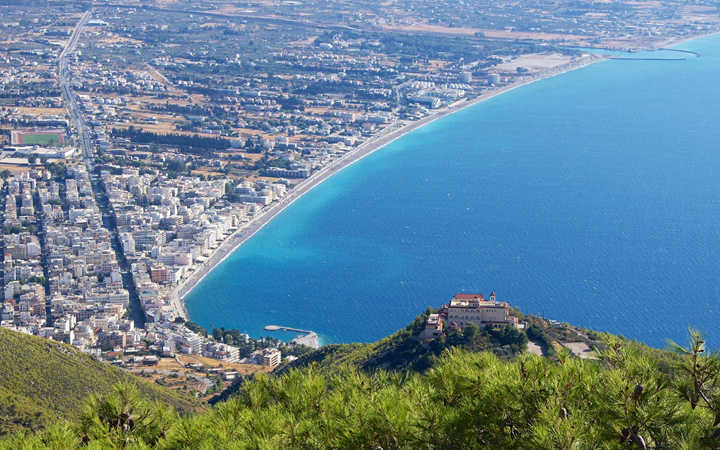From deepest antiquity the curative properties of the thermal springs of Loutraki have been a byword for natural healthy living, physical welfare and rejuvenation of body and spirit. It has been well-said of these springs that they are the ''the waters of life.''
The waters of Loutraki have always been famous for their healing and beneficial properties. They have provided, and still provide, prevention and treatment for musculoskeletal problems, skin and physical diseases, and cleansing of toxins from the human body.
In this state of the art facility, we offer unique opportunities to renew body and mind, to relax and pamper yourself with body and facial treatments, which include:
Loutraki- Spa on the Gulf of Corinth
If you look at a map of Greece, the Gulf of Corinth resembles a large, two-finned shark swimming southeast. The shark even has an eye, the grouping of three small islands known as the Alkionides (Halcyon) Islands. The shark’s mouth is open. Corinth would be at the bottom of the lower jaw, and Loutraki 3 miles (5km) northeast, would be at the very tip of the lower jaw, where the lower teeth would start.
Loutraki used to be called Thermi in antiquity, for the thermal springs there. “Loutraki” is a similar, more modern name, meaning “little bath.” The thermal springs still operate in this area of busy geologic activity: the town was completely leveled by an earthquake in 1928.
In addition to its famous spa, the area around the “mouth of the shark” has a some fascinating tourist attractions. For one, there’s Ancient Corinth. By the time the Apostle Paul visited this commercial metropolis in 54 AD, Corinth had far eclipsed Athens, which had been declining for centuries. Its population by all accounts was in the low hundreds of thousands, making it by far the biggest city in Greece. It was a lively, boisterous sailor’s town, world-famous for its debauchery. Rather than sail around the hazardous tip of the Peloponnese, ships would dock at Corinth’s port, offload their goods to save weight, be winched on top of an 8-wheeled platform (olko), and be pulled along the grooved, stone-paved diolkos, a sort of man-powered, 4.2 mile (6.8 km) long track way across the narrow isthmus separating the Corinthian and Saronic Gulfs, and let back down into the waters of the Saronic Gulf, where the ship was re-loaded, sailing on to Athens and points east. You can still see some of the surviving portions of the grooved-stone track way of the diolkos, which approximately follows the route of the Corinth Canal.
While waiting for their ships to be winched and manhandled across the Isthmus, idle sailors would get drunk in town, and make the trek to the Temple of Aphrodite on top of the 1,800 (575m)-high monolithic Acrocorinth, the most impressive acropolis in Greece and home to over a thousand temple prostitutes.
One of the most interesting spots in Ancient Corinth from a historical standpoint is the “Bema (“Judgment Seat”)," the only spot in the world where one can say without a doubt that the Apostle Paul stood there, when he was brought before Gallio, Procounsul of Achaia, by local Jews on the charge of “persuading people to worship God in ways that are contrary to the law.”
An early morning drive to the top of the Acrocorinth affords you an unforgettable view of the plains of Achaia stretching westward, with the shadow of the massive Acrocorinth seeming to go on for miles across the landscape. The waters of both the Gulf of Corinth and the Saronic Gulf are clearly visible, with the narrow neck of land between mainland Greece and the Peloponnese a tenuous strip barely uniting the two land masses.
Perachora is a peninsula across the water from Corinth, about 5 miles (7km) from Loutraki. (Pera- "beyond, + chora- "land or country" = "The country beyond," or opposite. There is the land-locked saltwater Lake Vouliagmeni, shallow and clean, and quick to warm up in the early summer. Fishermen ply their trade on its waters, and tavernas dot the lakeshore, which has beaches for swimming.
There is also the Heraion of Perachora, dedicated to Hera, wife of Zeus, goddess of home and hearth. There is a west-facing stoa in the shape of the letter J, with the temple up the beach and inland a few hundred meters, which features a court closer to the low up thrust of rock at the shoreline. The cult of Hera worshipped there for about eight hundred years until the Romans stopped it in 146 BC. A play by Euripides has Medea, jilted wife of Jason the Argonaut, who married a young princess of Corinth, take her revenge by killing their two children and burying them at the Heraion. It is one of the oldest Myths in Bronze-age Greece, dating at least to 700 BC.
Behind Loutraki, at 650 meters (2,000 feet) above sea level, halfway to the peak of Mt. Geraneia, is the female Monastery of Saint Patapios, patron saint of dropsy (edema or abnormal swelling from fluid of any organ, or under the skin, or in the skull). Patapios was an ascetic from 4th century, AD Thebes in Egypt, and his relics found their way to a cave near Loutraki (Thermi) from Constantinople for safe-keeping from the invading Ottoman Turks in 1453. The relics were forgotten, then re-discovered in 1904, finally finding a permanent resting place at the monastery, which was founded in 1952.












